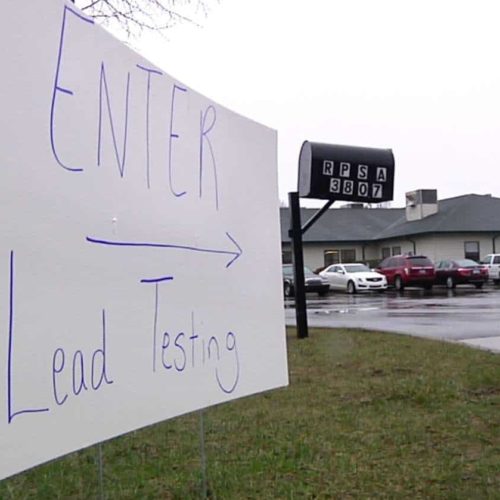Introduction
I shouldn’t have missed the story of lead-contaminated water in Flint.
Not because I’m an environmental reporter, but because my mom told me what was happening in my hometown, and I didn’t listen.
I tell people’s stories for a living. Our team at the Center for Public Integrity spent most of 2015 looking for examples of environmental discrimination — places where communities of color sat next to sewage plants, pesticide-covered fields and noxious landfills. Places where people went to meeting after meeting begging someone for help.
Our project detailed the Environmental Protection Agency’s limp enforcement of one mechanism to address discrimination — Title VI of the Civil Rights Act of 1964. Before I worked on it, I hadn’t realized how easy it is to ignore those fighting to be heard.
I grew up in a place a lot like the ones I now report on — Flint, Mich. I left after high school but return for holidays and milestones. In between, I call my mom for news. She still lives in the modest white house on the north side of Flint where I grew up. She’s spent most of the last 44 years there. The city long ago abandoned its part of the bargain, but she refuses to sell her hedge-lined piece of the American Dream.
When we talk, she usually details the latest city struggle — a new fee residents pay to keep street lights on in front of their homes; the police substation that closed up the street; her volunteer work with the abandoned-housing census. The day in August 2014 she casually mentioned a boil-water advisory, it didn’t even register. I brushed it off when she mentioned it again the next month. I ignored the loop of images in my Facebook feed showing hydrants flushing brown water. All of these things were routine, I reasoned. There’s nothing to worry about.
By now, you know the story.
In a cost-saving move, an emergency manager appointed by the state to oversee the city’s finances agreed to switch it from water supplied by the Great Lakes to water from the Flint River, once an industrial dump site. When the switch was made in April 2014, city officials toasted it with river water and called it “historic.”
That it was. Almost immediately, residents noticed something was wrong: Smelly, brown water came gushing from taps. People developed rashes after bathing. They complained to city officials, bringing jugs of that water to meetings. Officials maintained that the water was safe to drink. Now we know that was a lie.
From the emergency managers who ruled the city to Gov. Rick Snyder to the Michigan Department of Environmental Quality and the federal EPA, pretty much everyone messed up. Residents pleaded for help. Few listened.
That wasn’t new. There is a legacy Flint residents are taught to bear early: Take what is thrown at you without complaint; just find a way to survive it. For as long as I can remember, each day in Flint seemed to come with a new indignity to endure.
As a child, I held my breath as our car crossed the Stewart Avenue bridge to block the stench from the General Motors transmission factory below. My last Christmas home from Hampton University before graduation, tears forced me to the side of the road when I saw empty lots where factories once stood.
On campus, I brushed off jokes about how I “escaped” my hometown, with its reputation as one of the most dangerous cities in America. As an adult, I seethed as financial woes in Detroit were decried as a national tragedy; no one cared that this had been the reality in Flint for a decade.

No one expected much out of people from Flint, unless it was on a basketball court or a football field. The world, it seemed, would always try to mock or disregard us. We always have to prove ourselves worthy — even, apparently, of basic services we expect in America, like clean water.
As events unfolded last year, I would scroll through social media, getting lost in stories of what Snyder knew and when, or researching the horrific long-term effects of lead. I imagined the response if this had happened in the richer, whiter Detroit suburbs of Grosse Pointe or Bloomfield Hills instead of in my poorer, browner hometown.
I tried to figure out how I’d missed what was happening in Flint. The Flint Journal and Detroit Free Press were covering the story from the start. But I got most of my news from national outlets, and until the story elevated to that level I didn’t pay attention.
Paying attention is my job. I always saw journalism as a way to make a difference by amplifying the society’s unheard voices. Somewhere along the way, the plight of people in places unknown registered more than those in the place I knew intimately. Now I know that it’s easy to swoop into an unfamiliar town and tell someone else’s story. It’s a lot harder to recognize the things you became resigned to in your own life.
I’d bought into the idea that “Flintstones” could take anything, never once questioning why they should have to. Even after being immersed in research into environmental injustice, it was easy for me to write off discrimination in my city. If I could do it, how much could I expect from anyone else?
These days, Flint undulates in the news cycle. Plans to replace lead water lines have faltered. Lead levels in city water have dropped, but researchers say it’s still not safe to drink. Congress is looking at lessons to be learned from the debacle.
Few things are as invasive as poisoned tap water. On my worst days, I worry that this may be a knockout punch for my staggering city. I no longer live in Flint, but the crisis is still personal for me.
The people of Flint, meanwhile, survive.
Brown water never flowed from my home’s tap during the crisis, but my mom says she remembers the water smelling like “sewer vapor.” The last time I was there, I helped her unload 544 bottles of donated water from the car. We added them to the stockpile in our basement.
My mom is retired, but like others in Flint, she’s become a student of water contamination. She collects a quart of water from her kitchen sink — the only one without a filter — every two weeks in containers supplied by the state. The pink form she wraps around each bottle lists an identification number and her name, address and the date of collection.
When she’s done, she sets the water outside in a gallon plastic bag; state employees pick it up from her doorstep and test the water for lead and copper.
She’s participated in this ritual since March 1.
After the first four tests, my mom’s water came back clean. Last time, the state said in a letter that it contained lead. She isn’t sure what to believe. On the phone, she asks me questions I can’t answer: Why didn’t the earlier tests show any lead? Wouldn’t it have been there all of the time?
I can’t reassure her. She’s right; there’s no reason to trust anything she’s been told.
During these conversations, I’ve learned to do what I should have done the first time she told me about the bad water — and what the rest of America must do to prevent the next Flint. I listen.
Read more in Environment
Environment
‘It just ruined everything — the whole life’
Feeling abandoned by state regulators, hundreds of rural Pennsylvanians endure contaminated well water they blame on fracking
Environment
Hot mess: states struggle to deal with radioactive fracking waste
Potentially dangerous drilling byproducts are being dumped in landfills throughout the Marcellus Shale with few controls


Join the conversation
Show Comments